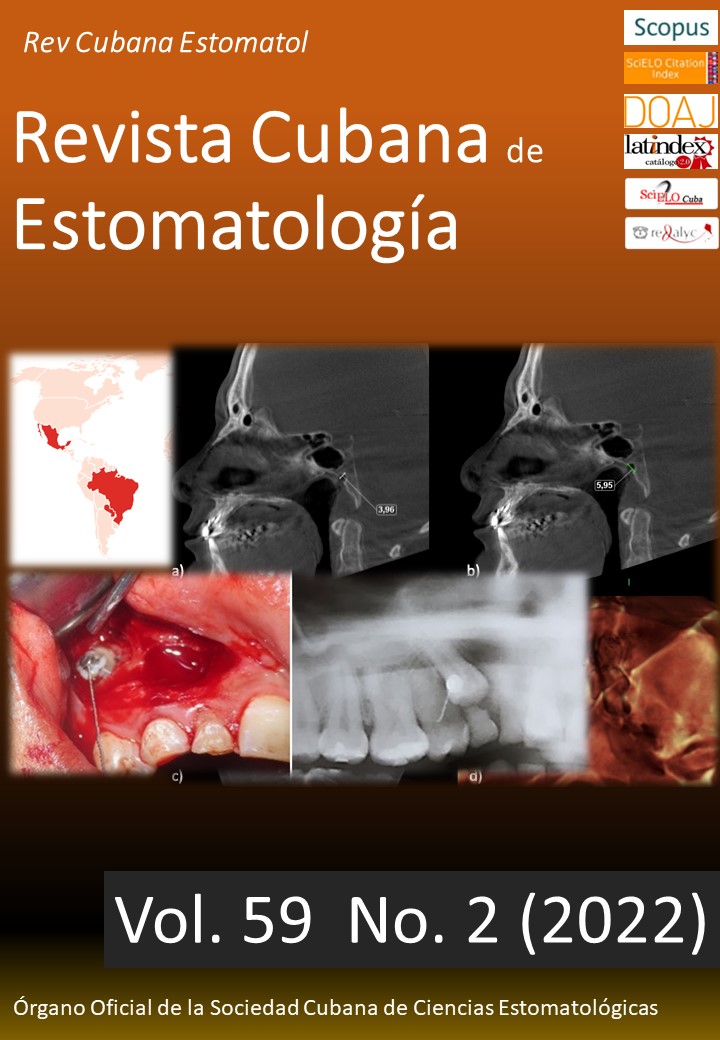Are “pink teeth” relevant to current forensics?
Keywords:
forensic dentistry, legal medicine, pink teeth, asphyxia, post mortem changes.Abstract
Introduction: “Pink teeth” are a post-mortem phenomenon characterized by a rose, reddish and even purple shade of color which may be observed in teeth. Their first reference dates back to 1829, when Thomas Bell described them. They have been a topic of debate for almost two centuries. The subject poses several questions: Would it be more logical to name them “red teeth” or “purple teeth”? What causes the increase in color intensity? Does the pink shade signal a specific cause of death? Does it remain forever or may it disappear for a variety of reasons?
Objective: Describe the indicators that “pink teeth” may still be considered an important element in current forensic research.
Main remarks: Based on the experience gathered from the cases analyzed in the last 20 years and the bibliographic review conducted, it is evident that the phenomenon appears mainly in anterior teeth and single-rooted premolars. On the other hand, pink teeth may be observed ante mortem as well as post mortem. For a number of reasons, post mortem pink teeth take several days to form, and they are a taphonomic phenomenon, present in violent as well as natural deaths, though their change in tone depends on various factors.
General considerations: Founded on the experience obtained by the authors and the bibliography about the topic, it is evident that this sign, phenomenon or finding (upon clarification of the questions posed) may still be very significant and enlightening in the current forensic context.
Downloads
References
Labajo M, Sánchez J, Buera B. “Postmortem pink teeth”: un curioso fenómeno. Revista de la Escuela de Medicina Legal. Enero 2006 [acceso: 12/03/2020]; 1(1):35-46. Disponible en: https://www.aacademica.org/elenalabajogonzalez/45.pdf
Palmieri J. Dientes Rosas. Estallido del paquete vásculo-nervioso en la cámara pulpar dental. Revista Skopein. Marzo-mayo 2015 [acceso: 07/03/2020]; 7:6-12. Disponible en: https://skopein.org/ojs/index.php/1/article/view/50/45
Franco A, Mendes S, Picoli F, Rodrigues L, Silva R. Forensic thanatology and the pink tooth phenomenon: from the lack of relation with the cause of death to a potential evidence of cadaveric decomposition in dental autopsies-case series. Forensic Sci Int. 2018; 291:8-12. DOI: 10.1016/j.forsciint.2018.08.011
Hernández O, Rubio M. Fenómeno de diente rosa o pink teeth. Odontología Actual. Octubre 2016 [acceso: 11/04/2020]; 13(162):28-30. Disponible en: https://189.240.63.5biblio.ujsierra/images/REVISTAS/estomatologia/Odontologia_actual_162.pdf
Campos W, Romero Flores E, Briceño B. Importancia del color dentario en la odontología forense: dientes rosas. Odontología Actual. Febrero 2015 [acceso: 06/03/2020]; 12(142):18-22. Disponible en: https://www.imbiomed.com.mx/articulo.php?id=104997&r=C
Villalobos K, Fernández J. Fenómeno de diente rosado en asfixia por sumersión. Presentación de caso. Medicina Legal de Costa Rica. Septiembre-diciembre 2016 [acceso: 27/02/2020]; 33(2):1-5. Disponible en: https://www.scielo.sa.cr/pdf/mlcr/v33n2/2215-5287-mlcr-33-02-133.pdf
Campobasso C, Di Vella G, De Donno A, Santoro V, Favia G, Introna F. Pink Teeth in a series of bodies recovered from a single shipwreck. The American Journal of Forensic Medicine and Pathology. 2006; 27(4):313-6. DOI: 10.1097/01.paf.0000233544.58567.81
Franco A, Navarro M, Gomes L, Ferreira V, Valente R, Blumemberg C. Case-specific characteristics of pink teeth in dental autopsies – A systematic review. Journal of Forensic and Legal Medicine. 2019; 68(1):1-8. DOI: 10.1016/j.jflm.2019.101869
Gowda B, Sivapatha B, Chatterji A, Chatterji B. Histological appearance of postmortem pink teeth: report of two cases. J Forensic Dent Sci. 2015; 7(1):168-170. DOI: 10.4103/0975-1475.156200
Van Wyk C. Postmortem pink teeth: in vitro production. J Oral Pathology. 1988; 17(9-10):568-72. DOI: 10.1111/j.1600-0714.1988.tb01336.x
Wallman J. Body farms. Forensic Sci Med Pathol. 2017; 13: 487-9. DOI: 10.1007/s12024-017-9932-z
Fowler K, Jack S, Lyons B, Betz C, Petrosky E. Surveillance for violent deaths-National violent death reporting system, 18 States, 2014. MMWR Surveill Summ S. 2018; 67:1-36. DOI: 10.15585/mmwr.ss6702a1
Birngruber C, Veit F, Lang J, Verhoff M. Inhaled cyanide intoxication as a vital sign in a room fire victim. Forensic Sci Int. 2017; 281:16-8. DOI: 10.1016/j.forsciint.2017.10.037
Briem A, Palmieri J. Diente rosado post mortem y Odontología Forense: Relato de caso pericial. Revista Skopein. Diciembre 2015-febrero 2016 [acceso: 07/03/2020]; 10: 74-9. Disponible en: https://skopein.org/ojs/index.php/1/article/view/73/67
Published
How to Cite
Issue
Section
License
Authors retain all rights to their works, which they can reproduce and distribute as long as they cite the primary source of publication.
The Rev Cubana Estomatol is subject to the Creative Commons Attribution-Non-Commercial 4.0 International License (CC BY-NC 4.0) and follows the publication model of SciELO Publishing Schema (SciELO PS) for publication in XML format.
You are free to:
- Share — copy and redistribute the material in any medium or format.
- Adapt — remix, transform, and build upon the material.
The licensor cannot revoke these freedoms as long as you follow the license terms.
Under the following terms:
Attribution — You must give appropriate credit, provide a link to the license, and indicate if changes were made. You may do so in any reasonable manner, but not in any way that suggests the licensor endorses you or your use.
- NonCommercial — You may not use the material for commercial purposes.
No additional restrictions — You may not apply legal terms or technological measures that legally restrict others from doing anything the license permits.
Notices:
- You do not have to comply with the license for elements of the material in the public domain or where your use is permitted by an applicable exception or limitation.
- No warranties are given. The license may not give you all of the permissions necessary for your intended use. For example, other rights such as publicity, privacy, or moral rights may limit how you use the material.


